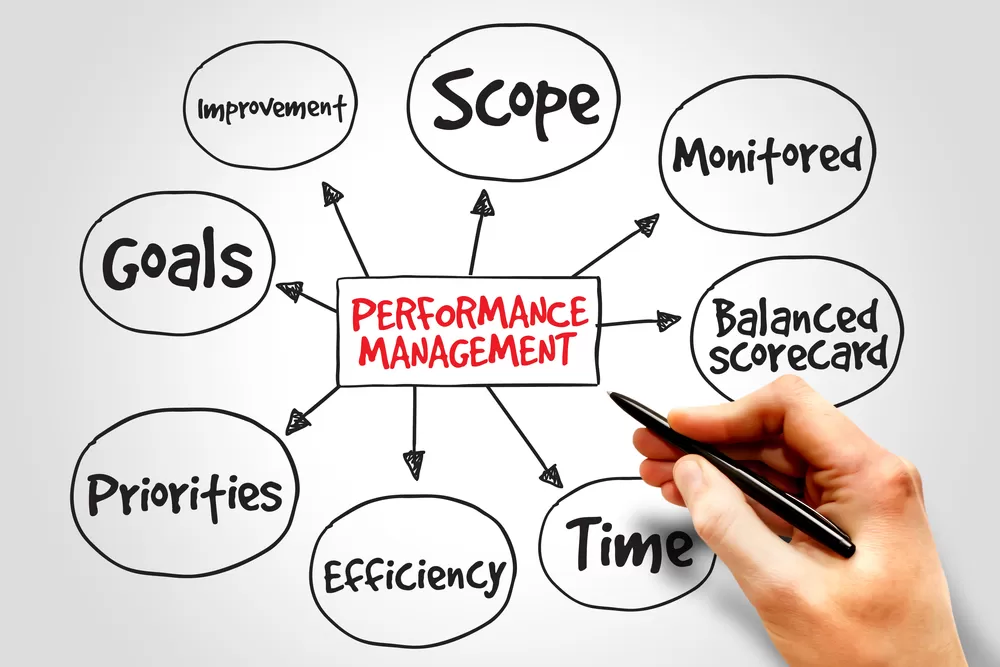To optimize employee performance, it’s necessary to have systems in place to record specific employee goals and then measure each employee’s performance as it pertains to achieving those goals. It’s essential for goals to be well-defined and effective systems to be established to achieve optimal performance. Still, once these key pieces are in place, HRIS software can make performance tracking and management more straightforward. HRIS can also help management produce highly effective performance reviews to improve performance management further.
What is Performance Management?
Performance management is the process of meeting your company’s performance-related goals in an efficient way. These goals can be related to the organization’s performance as a whole, or it can refer to the performance of departments or individual employees. Performance management can also refer to any processes that you have in place to manage specific tasks. A HRIS can be used to make the process much easier and more efficient.
Steps to HR Performance Management
Performance management in HR is a never-ending process. It’s also collaborative and communication-based, as HR works with employees and departments to achieve company goals. Four major steps in the performance management process can apply to any performance management, whether it’s a project or a department.
These steps are:
- Planning
- Coaching
- Review
- Reward
Planning Stage
Planning is the first step in the performance management process. This is the stage in which management and HR define the goals and objectives. Whether you’re planning a specific project, company-wide goals, or employee skill improvement, it’s important to clearly define key objectives and both short- and long-term goals. It’s also a good idea to define how you will measure the success or failure of those goals.
Any employees affected by this plan should have the opportunity to review the plan. They may have some input that could improve the plan.
Coaching Stage
The next step in the HR performance management process is coaching. This stage involves any necessary training as well as coaching opportunities. Employees and departments should get consistent feedback as they work to meet their goals. There shouldn’t be any punitive measures taken if someone isn’t meeting expectations. The coaching stage is meant to be a learning process on both sides. It may be that the original goal wasn’t realistic and needs to be adjusted based on employee feedback. Regular check-ins with the relevant employees and managers can go a long way toward ensuring that everyone remains on the same page.
Review Stage
The third step is the review stage. The review includes an annual employee performance review and a review of how well goals were achieved during the performance management period. Information from the regular check-ins during the coaching stage can show an employee’s progress over the year. While the check-ins were to help the employee with any specific problem-solving or tasks, the review is to look back throughout the year at the overall performance.
In this stage, it’s also important to assess the performance management process itself. Performance management aims to help employees and department meet their goals. If the process doesn’t achieve that objective, some adjustments may be needed to improve it.
For both employees and management, actionable feedback is key to improving performance going forward.
Reward Stage
The final step is to offer rewards and recognition for your employees’ hard work during the performance management process. The reward doesn’t necessarily have to be monetary, but a bonus can be a highly effective motivator for many employees. Whether you offer a reward or not, recognition is important. Employees need to feel that their efforts have been recognized and are valued by the company in order to continue to perform well.
How to Choose an HR Performance Management System
Before you search for an HRIS with performance management tools, it’s important to have a good idea of exactly what your company needs from the system. Different HRIS solutions will have different feature sets, but certain key performance management features are common across HRIS software. These can include employee performance review tools, performance tracking, goal setting, and more.
What features should your performance management system have?
Optimal Goal Setting
Although technology has changed many aspects of human resources management, using the “SMART” acronym is still helpful when setting goals. Making goals Specific, Measurable, Attainable, Relevant, and Timely can help employees be more clear on the goals and how and when to achieve them. This can help with prioritization for both employees and managers.
Performance Tracking
HRIS can help to alter the view of employee performance from a “snapshot” approach to a “progressive” approach. With employee performance being tracked on paper, it is difficult to see the continuous process of employee development and performance. With employee data being saved and available in one place using HRIS, the journey becomes clearer, and it is easier to spot patterns and see improvements or opportunities.
Faster Feedback
The data about employee performance that is gathered and tracked using HRIS should not be moving in only one direction. Managers benefit greatly from using HRIS features to give employees feedback on a highly regular basis, whether it’s on a day-by-day or goal-by-goal basis. By showing employees exactly what was done right and what could be improved as projects are completed, managers can dramatically improve productivity and the quality of work.
Actions Tied to Consequences
If employee performance management is disorganized or untimely, employee actions may not be tied directly to consequences. This is dangerous, as it undermines the effectiveness of incentives and penalties in managing employee performance. The real-time reporting that HRIS allows managers to have access to allows managers to respond to employee performance immediately, rewarding great performance as it occurs and working with employees to improve poor performance before the bottom line is affected.
Peer Feedback Collection
Using HRIS to track numerical results only is a mistake. HRIS opens up opportunities to include feedback about employees from other employees, managers in other departments, customers, and the employees themselves when tracking performance. Reviewing information from all of these sources may give managers a better-rounded view of an employee’s performance and allow managers to personalize employee development methods more effectively.
Performance Reviews
When HRIS is used regularly to track employee achievements, training, and errors, generating performance reviews becomes much easier. It is no longer necessary for managers to try to remember events immediately after the last review or to arbitrarily gauge overall progress. Concrete facts and notes are available in the system, so managers can review the employee’s performance and give a review based on the whole picture of the employee’s life within the company rather than pieces gleaned from past reviews and impressions.
Is your company looking for a HRIS to optimize your employee performance management? Look no further than our Software Match page. We’ll help match you with the software that will suit your company’s needs best.












